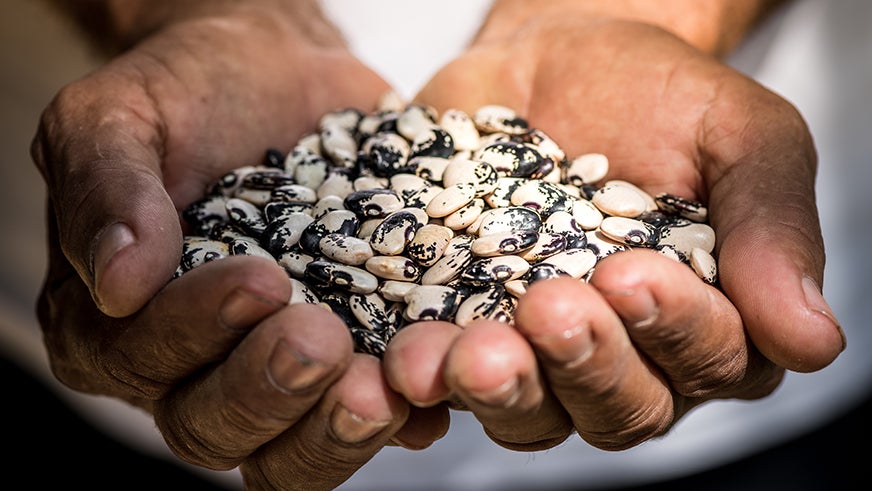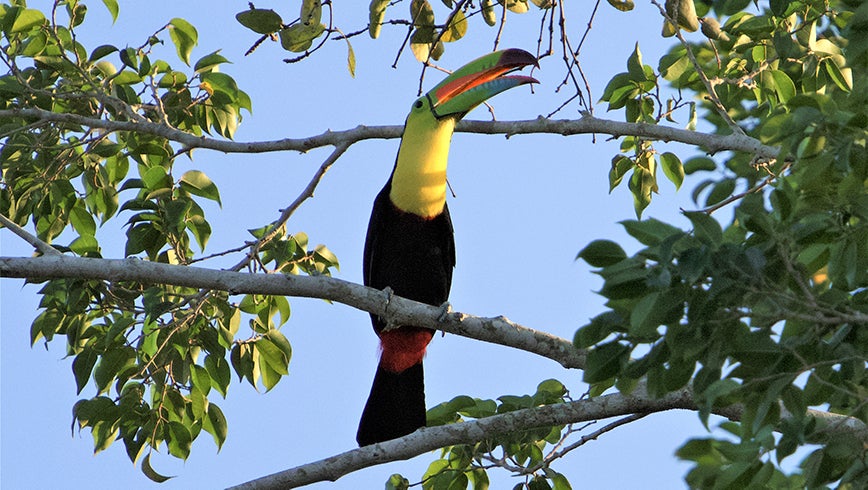
Particularly memorable meals and favorite dishes evoke happy moments, remind us of our childhood with their smells and flavors, or transport us to places we have never been before.
That happiness is the reason why Carmen Rodríguez gets up in the morning. A plate of colourful beans, cooked yellow yams, and a good coffee give her the energy to grow her crops in an isolated group of small mountains in the Caribbean region of Colombia known as Montes de María.
Carmen has lived in Montes de María for many years, preserving the last fragments of the tropical dry forest. Although Carmen has enjoyed the abundant biodiversity of this magnificent region, she had to abandon her land temporarily due to the brutal violence that impacted Montes de María during the past 30 years.
The things they carried
In containers made with totumo (calabash tree), an emblematic tree of the dry forest, Carmen and her family have kept for years the native seeds that the forest gave them.
"We left in 1999 because of the violence. When we left, we lost the crops, the animals, everything, but we always carried the seeds with us. Now they are back. We are recovering what makes us 'montemaríanos' and we want to share it with the world."

The forest of a thousand colors
The forest where Carmen lives is just as extraordinary as the seeds she protects.
The tropical dry forest in Colombia - the most endangered forest ecosystem in Colombia - is known as the forest of a thousand colors. It is distinguished by its many trees blooming in brilliant shades just before the first drops of the rainy season, when the forest turns thousands of shades of green.
Experts in adaptation, during the summer, the trees of the dry forest lose their leaves, but with the first drops of the rainy season the forest blooms again, exploding in a profusion of color.
These forests have protected an incalculable variety of seeds for farmlands and biodiversity. A total of 2,569 species of plants live here, of which 83 are endemic to this forest.
For years, farmers like Carmen adapted to the rhythms of the forest. Sudden heavy rains and long periods of drought shaped the lives and crops of these communities, who patiently protect and sow seeds adapted to climate extremes.
In the Caribbean and Andean regions, the Ministry of Environment and Sustainable Development, United Nations Development Programme (UNDP), and the Global Environment Facility (GEF) have jointly partnered with local communities to address the loss of the dry forest ecosystem and promote peace in Montes de Maria under the banner 'Forests 4 Peace.'
During the last 5 years, the government of Colombia, led by the Ministry of Environment and Sustainable Development with the support of UNDP and its strategic partners have conserved 33,400 hectares of dry forest in Montes de María and other regions together with local communities through conservation agreements, in-situ conservation strategies, agroforestry projects, and enrichment of the dry forest with native species.

Future food, future forests
Today, during the post-conflict period, local communities have returned to Montes de María and are using nature-based solutions to increase their income, fight climate change, improve their livelihoods, and promote connectivity between the remaining fragments of dry forests.
Under the leadership of Carmen, families in her community are actively working on nature-based solutions such as fruit gardens, cocoa production, nurseries with native seeds of indigenous varieties of grains, eco-efficient stoves to reduce wood consumption, silvopastoral systems, beekeeping, and community tourism.
We sit in the shade of trees we did not plant
"We are planting the oxygen that you will breathe in the future," she states.
Carmen continued by describing the progress achieved to date by her organization - the San Jacinto farmers' association Asomudepaz.
Asomudepaz is fostering innovation, gender equality, and income generation through the conservation of the dry forest. They are also supporting women who - through science and traditional knowledge - are recovering seeds for the survival of the forest and local communities.

Spice of life
Seventeen varieties of beans, yams, colored corn, vegetables, and exotic fruits comprise some of the seeds that have passed from generation to generation, making them a fundamental part of the gastronomic tradition of families in the Montes de María.
Super seeds; food for the future
The seeds conserved by Carmen and Asomudepaz also possess some of the magic of children's stories.
For example, quarantine beans (fríjoles cuarentanos) only need 40 days to grow - they accelerate their growth to make the most of short rainy seasons. The local species of black beans bears fruit every year just before summer. Yam tubers become leafy plants. These and thousands of other seeds are the result of the undertaking of Carmen and 40 families from the Montes de María.
"In Asomudepaz, we are rescuing our native seeds. We used them in traditional foods, but we didn't know just how important they were. Now that we are planting them again, we are not just recovering the seeds, we are recovering our traditions."
Connectivity is essential for conservation & rehabilitation
Just like humans need other humans to connect and form functional societies, trees need other trees to thrive and constitute functional forests. This connectivity between trees facilitates the survival of the forest itself and the biological diversity it harbors.
Forests are also needed for the livelihoods of local communities. The communities supported by UNDP and partners are aware of this and they are planting native and food trees to connect the gaps between patches of forests so that birds and other animals have larger homes, shelter, and food in this fragmented ecosystem. Restoring the dry forest is also mitigating the impact of higher temperatures caused by climate change and providing water for local communities.

Forests 4 Peace - for health, for a sustainable future
Forests are rooted to the land and to the health of ecosystems, water systems, agriculture, and biodiversity. At a local and global level, forests are critical for human health. It is crucial that we set a path for nature recovery and recognize that thriving societies are dependent on a healthy natural world.
In Colombia, the protection of forests and biodiversity is facilitated by innovative biotechnology and in-situ conservation strategies. Nature-based solutions, which offer opportunities for sustainable rural development in megadiverse countries such as Colombia, are also particularly important in supporting this transition to peace.
As the novel coronavirus pandemic shuts down businesses globally and sends countries into lockdown, the disruptions are threatening to cut off supply chains and increase food insecurity.
Bolstering local food production and working to ensure the continuity of the food supply chain especially for the most vulnerable rural populations has great value. A model such as the one developed in Montes de María offers important options because it strengthens local ties and protects community food supplies by promoting the consumption of local foods and reducing dependence on external inputs.
Furthermore, the Montes de María experience provides a long term development vision, as it generates income and supports transformation of basic agriculture products, all while strengthening forest conservation. This effort has the potential to be scaled up and disseminated to many other regions.
Forests 4 Peace reflects the power of partnerships in accelerating the achievement of the 2030 Agenda for Sustainable Development. This project catalysed key sustainable development targets related to ecosystem protection, poverty reduction, food security, and climate change. In so doing, the project demonstrates that contributing to the close of development gaps ensures no one is left behind.
This piece was originally published on Exposure by UNDP Ecosystems & Biodiversity.





